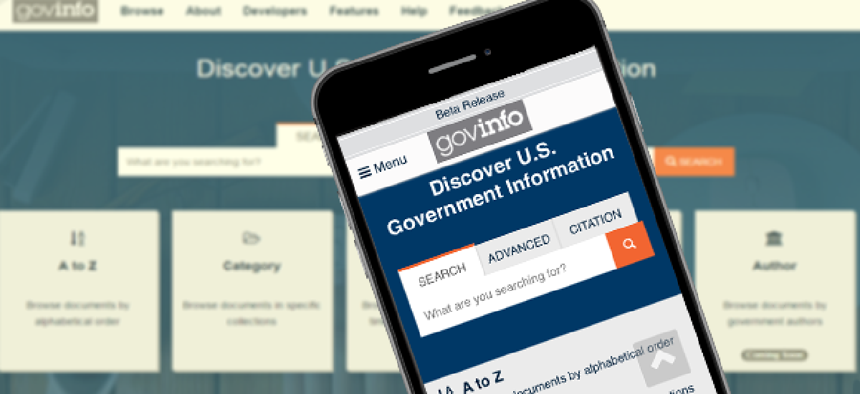How Govinfo keeps pace with users


Connecting state and local government leaders
A mobile-first strategy was a key driver in the Government Publishing Office’s latest iteration of the search site for government documents.
Ric Davis has seen his share of government documents. As CTO at the Government Publishing Office, he’s been an integral part of creating search engines to help the public find files from the executive, legislative and judicial branches. But on Feb. 10, a document Davis never expected found him.
It was a letter of commendation from House Speaker Paul Ryan (R-Wis.) congratulating him and his team on the release of Govinfo.gov, GPO’s latest search engine for finding authentic government documents.
“In our digital age, it is important for the government to use all of the tools at our fingertips to create true transparency,” Ryan wrote. “You recognized the need to digitize documents when the Internet was new, and you kept up with the ever-evolving technology of the day. I believe Govinfo will be a great success and I look forward to the permanent website.”
“This was quite a surprise,” Davis said.
The system that caught Ryan’s attention -- Govinfo.gov -- was released Feb. 3 in beta form. In a year, it will replace GPO’s Federal Digital System (FDsys), which replaced the original search system, GPO Access, in 2009. Currently, FDsys and Govinfo run in tandem; a search on either will yield the same results. A big difference between the two, however, is that GPO used a mobile-first strategy to build Govinfo.
The result is a responsive design, meaning Govinfo displays and functions equally well on a laptop or desktop computer or a mobile device. And that ability a big reason why Davis and his team opted to replace FDsys, not update it.
“We did extensive usability testing; we did a lot of use cases with all of our various constituencies, ranging from the general public, the library community, members of Congress, other federal agencies -- all the constituencies we serve,” Davis said. Mobile access was a key driver, and “we really weren’t positioned to update the site. We needed to really give it a new look and feel” and overhaul the home page to present all the information.
The main technology driver for this project, which was two years in the making, was the use of modern technology such as Backbone.js, JSON and jQuery to support the responsive interface, said Lisa LaPLant, Govinfo program manager.
“We also migrated over to an open source search engine, so we’re now using the Solr search engine,” an open source enterprise search platform from Apache, LaPlant said. “For the migration, we used a server replication technology to be sure we got all of the content and matched metadata all [moved] over from our old technology stack to the new Govinfo technology stack.”
That new stack includes virtualization, which “allows us to really be more efficient,” she said. “It also allows us to reduce our server footprint slightly. It’s definitely something that is very beneficial.”
The backend workings are mostly the same, however. Like FDsys, Govinfo, which has more than 1.5 million titles, uses the Open Archival Information System, a reference model from the International Organization for Standardization that specifies the concepts for a digital preservation system, for its preservation repository. Govinfo also uses the FDsys content management system and metadata tools for digitally signing documents. Additionally, metadata is still provided in XML.
One of Govinfo’s main new features is publication linking. “On Govinfo, we have the ability to take all of that content from the three branches -- and the metadata that we generated -- and make documents that are related to each other available in one place,” LaPlant said. “For example, as a bill is submitted and made available on Govinfo, I can go to a details page and see all versions of the bill, [and] when the public law becomes available, I can see the public law. And I can also see the [president’s] signing statement that is published in the compilation of public documents.”
Linking is done using Apache Jena RDF, an open source Semantic Web framework that lets an application programming interface extract data.
Other new features include shareable social media content and new ways to browse for information. For instance, Govinfo offers an alphabetical browse list and lets researchers search by calendar, committee, author or category, such as regulatory documents or publications from agencies.
On Feb. 9, GPO made the president’s fiscal 2017 budget available both on Govinfo and as an app, but Davis said he expects that’s the last time GPO will create such an app. The new responsive design makes one-off apps unnecessary, he said.
“Going back to the times of GPO Access to now, the two ways that people get to this information are search and browse. That has been a consistent activity for the last 20-plus years,” Davis said. “As we look over to the future, we’re going to continue to look at emerging trends in technologies, web design, user interfaces and the needs of our various constituencies to think about the best ways that we can get that information in their hands.”
NEXT STORY: NASA tech could trim air travel delays




